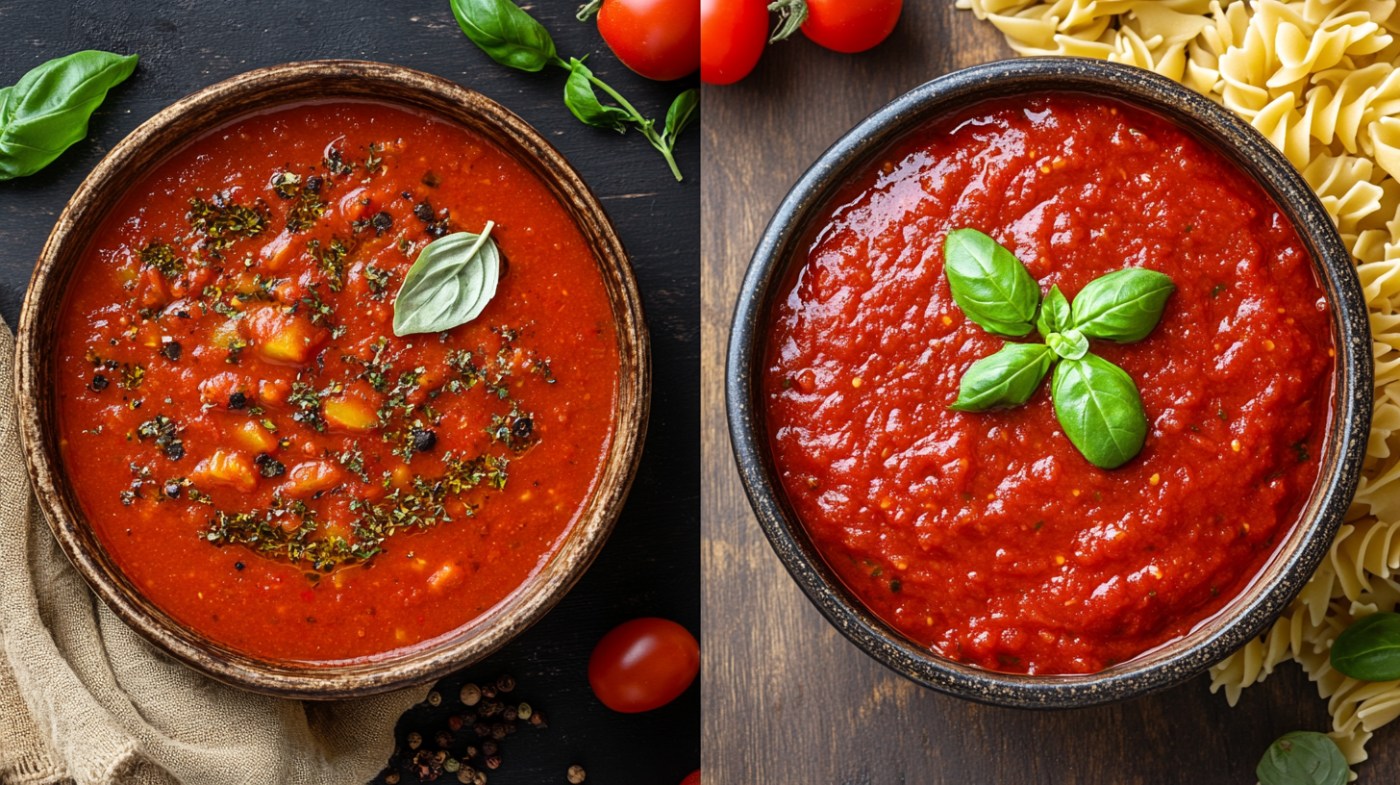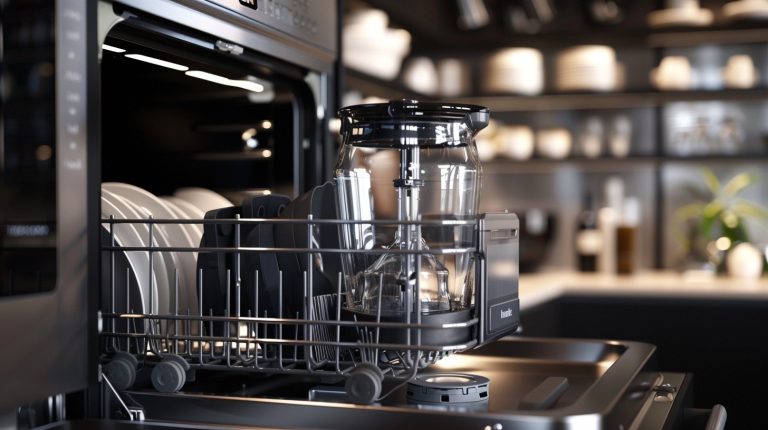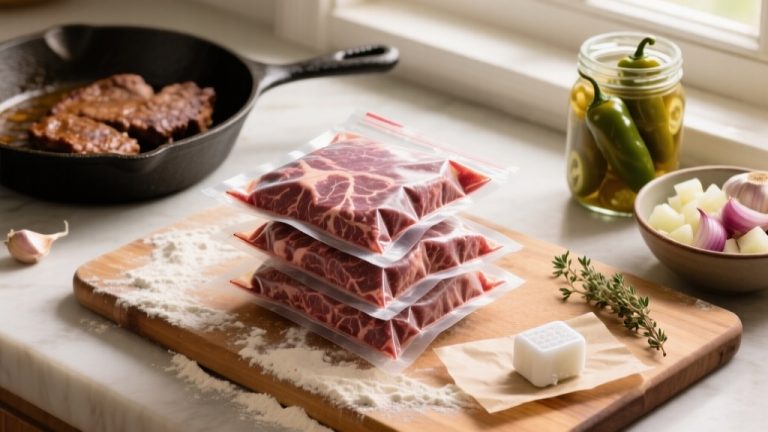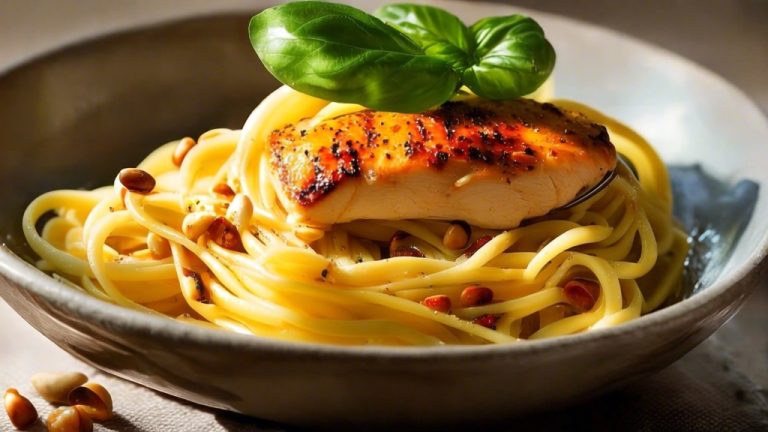Pizza Sauce Vs Pasta Sauce: What Sets Them Apart?
When you compare pizza sauce and pasta sauce, you’ll notice some key differences. Pizza sauce is typically uncooked, made with thick, smooth tomatoes and simple seasonings like oregano and garlic. It clings nicely to the crust and has a fresh, tangy flavor.
On the other hand, pasta sauce is cooked down, often incorporating a variety of ingredients for a richer taste, including onions, olive oil, and sometimes meat. It’s thinner and coats noodles beautifully.
Each sauce brings a unique twist to meals, and there’s much more to uncover about their culinary roles and preparation techniques.
Key Takeaways
- Pizza sauce is uncooked, while pasta sauce is cooked down to enhance flavors and consistency.
- Pizza sauce has a thicker, smoother texture, whereas pasta sauce is thinner and may contain chunks.
- The flavor of pizza sauce is fresh and zippy, while pasta sauce offers a sweeter, richer taste.
- Pizza sauce uses simpler seasonings like oregano and garlic, while pasta sauce incorporates a wider variety of herbs and spices.
- Marinara, a cooked sauce, is chunkier and more versatile than pizza sauce, which is specifically designed for pizzas.
Differences Between Sauces
When it comes to the differences between pizza sauce and pasta sauce, you’ll notice distinct characteristics that set them apart.
Pizza sauce typically remains uncooked, boasting a thicker consistency that clings to the crust, preventing it from becoming soggy. In contrast, pasta sauce is usually cooked down, resulting in a thinner texture that beautifully coats your noodles.
Flavor profiles differ considerably, too. Pizza sauce offers a fresher, zippier taste thanks to its raw ingredients, while pasta sauce provides a sweeter, richer flavor developed through slow simmering.
You’ll find that pizza sauce often contains simpler seasonings like oregano and garlic, while pasta sauce invites a wider array of herbs and spices, including basil and bay leaf.
Moreover, the water content in pasta sauce allows for chunks of tomatoes and additional ingredients, creating a hearty dish. Meanwhile, pizza sauce is smoother and more concentrated, designed for better adherence to the crust.
What You Need to Know about Pizza Sauce?
When you think about pizza sauce, picture a blend of uncooked tomatoes, vibrant seasonings, and that signature thick texture.
You’ll find that the preparation is straightforward, with raw ingredients coming together to create a fresh, tangy flavor that enhances your pizza.
Ingredients of Pizza Sauce
Creating the perfect pizza sauce starts with the right ingredients, and it’s easier than you might think. At the heart of pizza sauce are uncooked tomatoes, often in the form of plain tomato sauce or pureed tomatoes. This gives your sauce a thick, smooth consistency, essential for preventing soggy pizza dough.
To enhance the flavor, you might even consider the importance of seasoning to elevate your sauce to the next level.
To elevate the flavor, you’ll want to incorporate some classic seasonings. Oregano is a must, along with garlic powder and onion powder for that aromatic kick. If you’re looking to balance the tanginess, a pinch of sugar can work wonders.
Unlike pasta sauce, which tends to be chunkier, pizza sauce is all about concentration and smoothness. You can easily whip up a homemade version by mixing tomato sauce, tomato paste, and your favorite herbs. This way, you can personalize the flavor to your liking, making your pizza truly unique.
Another great aspect of pizza sauce is its convenience. You can prepare it quickly without any cooking, ideal for last-minute pizza nights. Plus, it can be refrigerated or frozen, so you always have it on hand for your next pizza adventure.
Preparation Techniques Explained
There’s something satisfying about preparing your own pizza sauce, and understanding the right techniques can make all the difference.
Start by choosing uncooked tomatoes, like tomato sauce or pureed tomatoes. This choice preserves that fresh, tangy flavor you love. To achieve the perfect thickness, mix in some tomato paste; this prevents your pizza dough from getting soggy when it bakes. Additionally, you can consider using homemade pizza sauce for a personalized touch, which can enhance the overall taste of your pizza.
Next, season your sauce to elevate its taste. Common seasonings like oregano, garlic salt, and a touch of sugar can create a zesty flavor that beautifully complements your cheese and toppings.
Remember, the magic lies in the fact that pizza sauce doesn’t undergo any cooking. This unique approach allows the vibrant tomato notes to shine through, giving your pizza a fresh taste.
Once you’ve mixed your ingredients, let them rest for at least 30 minutes. This resting period allows the flavors to meld, ensuring every bite is delicious.
Flavor Profile Characteristics
Mastering the preparation techniques for pizza sauce sets the stage for exploring its unique flavor profile. Unlike pasta sauce, pizza sauce boasts a fresh, zippy tomato flavor that comes from its uncooked nature, preserving the raw taste of tomatoes. You’ll notice that the seasoning is simpler too, often highlighting herbs like oregano and basil while steering clear of the complex blends typical of pasta sauces.
Here’s a breakdown of the key flavor characteristics:
| Characteristic | Description |
|---|---|
| Tomato Flavor | Fresh and zesty, thanks to uncooked tomatoes |
| Seasoning | Simpler, focusing on oregano and basil |
| Consistency | Thicker, allowing better adherence to dough |
| Tanginess | Enhanced with garlic salt and sugar |
| Overall Profile | Bright and vibrant, complementing cheese fats |
This vibrant flavor profile guarantees your pizza remains deliciously distinct, enhancing every bite without overwhelming you. The balance of tanginess and tomato brightness makes pizza sauce a perfect match for the richness of cheese, ensuring a delightful culinary experience.
Getting a Better Understanding of Pasta Sauces
Pasta sauce serves as a flavorful foundation that elevates your favorite noodle dishes. Typically made with crushed tomatoes, it boasts a thinner consistency that allows for even coverage on your pasta.
You’ll often find a medley of ingredients like olive oil, sautéed garlic, and onions, which create a rich base. For those seeking a meaty version, ground beef or Italian sausage adds depth, making each bite a delightful experience.
When preparing pasta sauce, consider using a food processor for efficient chopping of ingredients; this can save time and guarantee uniformity in your sauce’s texture.
The magic happens during the slow simmering process. This technique melds the flavors together, enhancing the sauce’s richness and complexity. Basic seasonings like salt and pepper are essential but don’t shy away from experimenting with dried herbs such as oregano, basil, or even bay leaves to elevate the taste.
If you’re looking for a simpler option, marinara sauce is a fantastic choice. It consists of just tomatoes, garlic, onions, and herbs, making it a versatile base for various dishes—beyond pasta.
Comparing Pizza Sauce and Marinara
When it comes to sauces, pizza sauce and marinara each offer unique flavors and textures that cater to different culinary experiences.
Marinara sauce is a semi-smooth, tomato-based blend made with tomatoes, garlic, herbs, and onions. Its longer cooking process melds the flavors beautifully, resulting in a chunkier texture thanks to diced tomatoes. This versatility makes marinara ideal for pasta dishes, sandwiches, and dips.
On the other hand, pizza sauce is thicker and primarily made from uncooked pureed tomatoes or tomato paste. This uncooked nature preserves the fresh, tangy taste of the tomatoes, providing a smoother, more concentrated sauce that adheres perfectly to your pizza dough.
While marinara may include additional ingredients like olives or ground meats for complexity, pizza sauce keeps it simple with just oregano and basil, crafted specifically to enhance the flavors of various pizza toppings.
Homemade Pizza Sauce Recipe
If you want to elevate your pizza game, making homemade pizza sauce is a must.
You’ll need key ingredients like San Marzano tomatoes, fresh basil, and a touch of sea salt, all of which create a bold flavor that’ll impress your taste buds.
Key Ingredients Overview
For a truly delicious homemade pizza sauce, you’ll want to focus on a few key ingredients that elevate its flavor. Start with a 28 oz can of San Marzano tomatoes, known for their rich and sweet taste. You can crush these tomatoes by hand or with a masher, giving you control over the sauce’s consistency—whether you prefer it chunky or smooth.
To maintain the quality of your ingredients, consider proper freezing practices for any extra sauce you might want to store for later use.
Next, don’t underestimate the significance of seasoning. Sea salt is crucial, so adjust it to your taste and guarantee your sauce isn’t bland or overly salty. Olive oil adds a silky texture and enhances the overall flavor, bringing the other ingredients together beautifully.
Fresh herbs like basil and oregano are fundamental for that aromatic kick. They infuse the sauce with a zesty freshness that pairs perfectly with your chosen pizza toppings.
Preparation Steps Explained
In just a few simple steps, you can create a flavorful homemade pizza sauce that transforms your pizza night.
Begin by grabbing a 28 oz can of San Marzano tomatoes and pouring it into a bowl. Sprinkle in some sea salt and add a drizzle of olive oil for richness.
Now, it’s time to crush those tomatoes! You can use your hands or a masher to get the consistency you prefer—smooth or slightly chunky.
Next, add in fresh basil and oregano, adjusting the amounts to suit your taste. This step brings a vibrant flavor profile that will elevate your sauce.
Once everything’s mixed together, let the sauce rest for at least 30 minutes. This resting period allows the flavors to meld beautifully, enhancing the overall taste.
If you have leftover sauce, don’t worry! You can store it in the refrigerator for up to a week or freeze it for about two months, ensuring you always have a delicious sauce ready for your next pizza adventure.
Flavor Enhancements Tips
Enhancing the flavor of your homemade pizza sauce can elevate your pizza experience to new heights. Start with high-quality San Marzano tomatoes; their sweeter, less acidic profile can make your sauce sing.
To infuse freshness, add a handful of chopped basil and oregano. If you’re short on time, dried herbs work too—just remember, a little goes a long way!
Balancing the sauce’s acidity is key, so consider stirring in a touch of sugar. This simple addition can transform the sauce, enriching its flavors.
For an extra layer of depth, a splash of balsamic vinegar or a sprinkle of red wine can introduce a delightful tanginess that complements your cheese and toppings beautifully.
Don’t forget about garlic! Sauté minced garlic in olive oil before incorporating it into your sauce. This technique infuses the oil, creating a robust flavor that elevates the overall taste.
Flavor Profiles of Each Sauce
When you take a bite of pizza, the fresh, zippy tomato flavor of the sauce bursts in your mouth, a result of its uncooked nature that perfectly complements the baked crust and toppings. This bright flavor is often tangier and less sweet, making it a vibrant match for your favorite ingredients.
On the other hand, pasta sauce delivers a sweeter, richer experience. Its slow-simmered process allows the flavors to meld, resulting in a depth that dances on your palate.
Here’s a quick comparison of the flavor profiles:
| Flavor Aspect | Pizza Sauce | Pasta Sauce |
|---|---|---|
| Base Flavor | Fresh, zippy tomato | Sweet, rich tomato |
| Cooking Method | Uncooked | Slow-simmered |
| Seasoning | Simple (salt, pepper, herbs) | Complex (varied herbs/spices) |
| Sweetness Level | Tangy, less sweet | Sweeter, often includes sugar |
Cooking Techniques for Sauces
Cooking techniques play an essential role in defining the character of pizza and pasta sauces. Understanding these methods helps you choose the right sauce for your dish, enhancing the flavors and textures you want to achieve.
For pizza sauce, you typically use an uncooked approach, which preserves the vibrant taste of fresh tomatoes. Here’s what you should know about the techniques:
- Fresh Ingredients: Use raw tomatoes and herbs to maintain bright, bold flavors.
- No Cooking Required: Simply mix your ingredients, letting the heat from the oven do the work as it melds with the dough.
- High Temperatures: Bake at 400-500°F to allow the sauce to interact with the cheese and crust, creating a unique flavor profile.
- Quick Application: Spread it directly on the dough before baking for maximum freshness.
In contrast, pasta sauce benefits from a slow simmer, which deepens flavors through caramelization and blending.
Common Misconceptions About Sauces
Understanding the distinctions between pizza sauce and pasta sauce can clear up many common misconceptions that often confuse home cooks. One prevalent myth is that all tomato-based sauces, like marinara and pizza sauce, can be used interchangeably. Each has unique ingredients, textures, and preparation methods that set them apart.
Another misunderstanding is that pizza sauce must be cooked first. In reality, it’s typically made from uncooked tomatoes, preserving that fresh, vibrant flavor and thick consistency you love.
Many also assume that the seasoning profiles are similar, but pasta sauce usually boasts a diverse range of herbs and spices, offering a richer, deeper taste.
It’s easy to confuse marinara with pizza sauce, yet marinara is a semi-smooth, cooked sauce with a more complex flavor, while pizza sauce remains straightforward and uncooked.
Finally, some people believe that sugar is a must in all tomato sauces. In pasta sauce, sugar helps balance acidity, whereas pizza sauce sticks to its tangy essence without the added sweetness.
Culinary Uses and Alternatives
Pizza sauce and pasta sauce each play an essential role in their respective dishes, enhancing flavors and textures in unique ways. When you think about culinary uses, here’s how these sauces differ and where they can overlap:
- Pizza Sauce: Thick and rich, it acts as a base, preventing soggy dough and amplifying topping flavors.
- Pasta Sauce: Designed to coat noodles, it offers a variety of tastes, often incorporating meats and vegetables for depth.
- Marinara Sauce: A thinner alternative, great for pasta but can work on pizza if you’re looking for a lighter option.
- Creative Alternatives: Consider using pesto or barbecue sauce for a twist on classic flavors, enhancing your pizza experience.
If you want to use pasta sauce on pizza, you can easily modify it. Strain it for thickness, blend it for a smooth consistency, and adjust the seasonings to mimic that classic pizza taste.
This way, you can enjoy both sauces in new and exciting ways, expanding your culinary repertoire while satisfying your taste buds.
Frequently Asked Questions
Can I Use Pizza Sauce for Pasta Dishes?
Yes, you can use pizza sauce for pasta dishes! Just adjust its thickness with water or broth and enhance the flavor with garlic, onion, or herbs. It adds a zesty twist to your meal!
How Long Does Homemade Pizza Sauce Last in the Fridge?
Homemade pizza sauce is like a cozy blanket, bringing warmth to your meals. It lasts up to one week in the fridge, but don’t forget to check for spoilage before using it. Enjoy it safely!
Are There Gluten-Free Options for Pizza Sauce?
Yes, there are plenty of gluten-free options for pizza sauce. You can choose pre-made sauces labeled gluten-free or whip up a homemade version using pureed tomatoes, herbs, and spices, ensuring all ingredients are safe for you.
What Are Common Herbs Used in Pizza Sauce?
Ever wondered what transforms a simple tomato base into something extraordinary? You’ll find common herbs like oregano and basil, alongside savory garlic, elevating the flavor. A sprinkle of Italian seasoning adds that perfect finishing touch.
Can I Freeze Pasta Sauce for Later Use?
Yes, you can freeze pasta sauce! Just let it cool completely, store it in airtight containers, and it’ll stay good for 3 to 6 months. Thaw overnight in the fridge for best results. Enjoy!
Dive Into Deliciousness: The World of Pizza and Pasta Sauces
When it comes to choosing between pizza sauce and pasta sauce, knowing their distinct flavors and uses can make all the difference in your cooking. Each sauce has its own personality, like a trusty old friend.
Whether you’re slathering it on a crispy crust or tossing it with your favorite noodles, understanding these sauces will elevate your dishes to new heights. So, roll up your sleeves and let your culinary creativity shine as you plunge into the delicious world of sauces.







